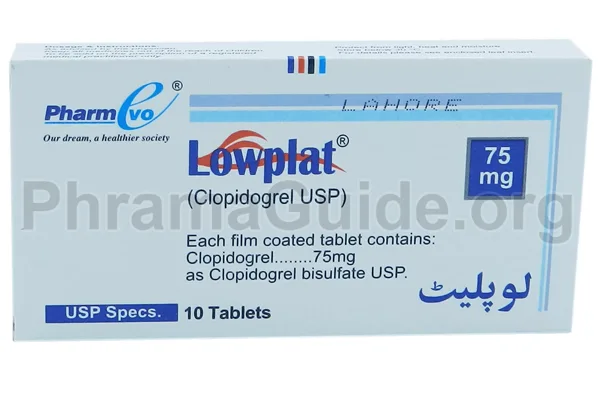Lowplat is a medication used to prevent blood clots in people who have various heart and blood vessel conditions, including a history of heart attacks or strokes. Like many medications, Lowplat can have side effects, with some being more common than others. It’s important to note that not everyone will experience these side effects, and some individuals may not experience any side effects at all.
Common Side Effects
- Bleeding: This is the most common side effect of Lowplat. It can manifest as nosebleeds, bruising, gastrointestinal bleeding, or prolonged bleeding after injuries or surgery.
- Upset Stomach: Some people may experience nausea, indigestion, or abdominal pain using Lowplat.
- Diarrhea: Lowplat can occasionally cause diarrhea.
- Headache: Headaches are a relatively common side effect of Lowplat.
Less Common Side Effects
- Thrombotic Thrombocytopenic Purpura (TTP): TTP is a rare but one of the serious side effects associated with Lowplat. It is a condition that affects the blood’s ability to clot and can lead to widespread small blood clots. Symptoms may include fever, weakness, confusion, and small red or purple spots under the skin.
- Neutropenia: Using Lowplat can cause Neutopenia, this is a rare condition where the white blood cell count is dangerously low, increasing the risk of infection.
- Allergic Reactions: In some cases, people may experience allergic reactions to Lowplat, which can include skin rash, itching, and swelling of the face, lips, or tongue.
- Liver Enzyme Abnormalities: Elevated liver enzymes can occur in some individuals, although this is relatively uncommon.
- Severe Skin Reactions: Extremely rare but serious skin reactions, such as Stevens-Johnson syndrome and toxic epidermal necrolysis, have been reported with Lowplat use. These conditions involve severe blistering and peeling of the skin and require immediate medical attention.

What is Lowplat?
Lowplat is one of the leading brands of Clopidogrel, manufactured and marketed by PharmEvo Private Limited Pakistan.
Lowplat : Available Formulations and Strengths
Presently, Lowplat is available in Tablet Form
Lowplat Tablets : Clopidogrel 75mg Strength.
Lowplat Plus Tablet : Clopidogrel 75mg + Aspirin 75mg strengths.
What Are The Possible Drug Interactions of Lowplat?
- Anticoagulants (blood thinners): Taking Lowplat with other anticoagulant medications, such as warfarin or heparin, can increase the risk of bleeding. It’s important to monitor and adjust the dosage carefully if these drugs are prescribed together.
- Proton Pump Inhibitors (PPIs): PPIs like omeprazole, esomeprazole, and lansoprazole, which are used to reduce stomach acid, can potentially reduce the effectiveness of Lowplat. This interaction is a subject of debate among healthcare professionals, but it is still recommended to discuss the use of PPIs with your doctor if you are taking Lowplat.
- Nonsteroidal Anti-Inflammatory Drugs (NSAIDs): NSAIDs like ibuprofen and naproxen can increase the risk of bleeding when used with Lowplat. It’s important to use NSAIDs with caution and under the guidance of a healthcare provider if you are on Lowplat.
- Selective Serotonin Reuptake Inhibitors (SSRIs): Some SSRIs, such as fluoxetine and fluvoxamine, may increase the risk of bleeding when taken with Lowplat. Your doctor may choose an alternative medication or closely monitor your condition if you need both.
- Cilostazol: The combination of Lowplat and cilostazol may increase the risk of bleeding. Your healthcare provider will monitor your condition closely if you are prescribed both medications.
- Certain Antifungal Medications: Some antifungal medications, like fluconazole, can potentially interact with Lowplat and affect its effectiveness.
- Certain Antidepressants: Monoamine oxidase inhibitors (MAOIs) and tricyclic antidepressants can increase the risk of bleeding when taken with Lowplat.
- Ginkgo Biloba: This herbal supplement may increase the risk of bleeding when used with Lowplat.
- Green Tea: Green tea contains compounds known to interfere with blood clotting and may increase the risk of bleeding when used with Lowplat.
- Alcohol: Excessive alcohol consumption can increase the risk of bleeding when taking Lowplat. It’s advisable to limit alcohol intake while on this medication.

Leave A Comment